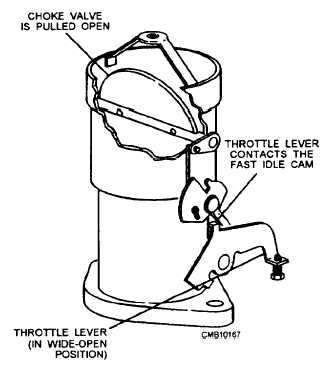by the choke unloader (fig. 4-38). The choke unloader can be either mechanical- or vacuum-operated.
A mechanical choke unloader physically opens the choke plate any time the throttle swings fully open. It uses a metal lug on the throttle lever. When the throttle lever moves to the fully opened position, the lug pushes on the choke linkage (fast idle linkage). This provides the operator a means of opening the choke. Air can then enter the air horn to help clear a flooded engine (engine with too much liquid fuel in the cylinders and intake manifold).
A vacuum choke unloader (fig. 4-39). also called a choke brake, uses engine vacuum to crack open the choke plate as soon as the engine starts. It automatically prevents the engine from flooding.
Before the engine starts, the choke spring holds the choke plate almost completely closed. This action primes the engine with enough fuel for starting. Then as the engine starts, the intake manifold vacuum acts on the choke brake diaphragm. The diaphragm pulls the choke linkage and lever to swing the choke plate open slightly. This action helps avoid an overly rich mixture and improves cold engine drivability.

Figure 4-38. - Choke unloader.

Figure 4-39. - Vacuum choke unloader.
CARBURETOR ACCESSORIES
There are several devices used on carburetors to improve drivability and economy. These devices are as follows: the fast idle solenoid, the throttle return dashpot, the hot idle compensator, and the altitude compensator. Their applications vary from vehicle to vehicle.
Fast Idle Solenoid
A fast idle solenoid, also known as an antidieseling solenoid (fig. 4-40), opens the carburetor throttle plates during engine operation but allows the throttle plates to close as soon as the engine is turned off. In this way, a faster idle speed can be used while still avoiding dieseling (engine keeps running even though the ignition key is turned off). This is a particular problem with newer emission controlled vehicles due to higher operating temperatures, higher idle speeds, leaner fuel mixtures, and lower octane fuel.
When the engine is running, current flows to the fast idle solenoid, causing the plunger to move outward. The throttle plates are held open to increase engine speed. The plunger is adjustable, so the idle speed can be adjusted. When the engine is turned off, current flow to the solenoid stops. The solenoid plunger retracts and the throttle plates are free to swing almost closed.
Throttle Return Dashpot
The throttle return dashpot, also known as an antistall dashpot (fig. 4-41), acts as a damper to keep the throttle from closing too quickly when the accelerator pedal is suddenly released. It is commonly used on carburetors for automatic transmission equipped vehicles.
Continue Reading